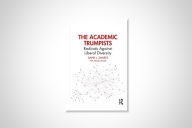You have /5 articles left.
Sign up for a free account or log in.
NEW YORK -- Higher education's own hiring practices are undermining one of its chief selling points: that a college education fosters upward mobility, several speakers said here Tuesday at a conference on academic labor.
In particular, it is the condition of adjunct faculty members, which was the subject of several sessions of the annual meeting of the National Center for Collective Bargaining in Higher Education and the Professions, that casts the harshest light on the gap between academe's aspirations and its actual conduct.
“In order to maintain faith with higher education, you have to be able to confront the idea that a high proportion of the most educated portion of the population is having trouble making ends meet,” said Alan Trevithick, founding member of the New Faculty Majority and an adjunct who teaches sociology at Fordham University and Westchester Community College, during a session entitled “Contingent Faculty: Issues at the Table.”
Adjunct faculty make up an estimated two-thirds of the professoriate, and they typically earn far less than their tenured and tenure-track counterparts, often for doing similar work. Hard data or statistics on adjuncts can be hard to come by, many speakers said, in part because the term refers to different kinds of jobs and situations. Some adjuncts hold doctorates, have the same qualifications as their tenured and tenure-track colleagues, and teach full time (labels include full-time temporary faculty, per-course teachers, contingent labor or “precarious” faculty -- or more evocative terms like academic proletariat or sweatshop workers).
Others hold several part-time positions on individual campuses and travel from one to the next to cobble together a living (in California, they are often referred to as “freeway flyers”). Still other adjuncts teach one or two courses and have other sources of income -- perhaps because they work in an industry related to the subject they teach, or are retirees and are drawing a pension. Even though their employment status is often called precarious or contingent, adjuncts can teach at their institutions for decades.
In the wider economy, of course, data consistently affirm that earnings increase with educational attainment. But, in higher education, the disparity in the working conditions of highly educated adjuncts as compared to those of full-time faculty has grown so pronounced as to be seen as scandalous by some at the conference (though most of those at the sessions on adjuncts were themselves adjuncts, union leaders, or negotiators, with few administrators in sight).
This disparity, which many speakers said began 20 or 30 years ago and has only grown, has become deeply embedded in the structure of higher education -- to the benefit of some and the detriment of many others.
“The non-tenure-track faculty make the tenure-track research positions possible,” said Robert Samuels, a lecturer in the writing programs at the University of California at Los Angeles and president of the University Council, American Federation of Teachers. The adjunct faculty serve this enabling purpose in two ways, said Samuels: they assume much -- and in many cases, the majority -- of the teaching load, thus freeing up time for full-time faculty to do research; and their lesser salaries for teaching highly enrolled undergraduate courses also result in net revenues that essentially subsidize other, more costly work at the university.
But the prevalence of adjuncts also carries risks to the quality of higher education, which will make it more difficult for colleges to meet other goals, such as the objective of dramatically increasing the proportion of adults holding postsecondary degrees or certificates, argued Richard Boris, executive director of the conference, during a session Monday. Students stand to lose out if too many of their instructors are harried and juggling multiple appointments (adjuncts, however, counter by saying they have more expertise in teaching because they tend to do it more than their tenured colleagues). “It's like condemning these kids to a succession of foster families rather than real families,” said Boris. “It's a scandal that we on both sides of the table have made labor cheap.”
The lesser status of adjuncts is also increasingly reinforced by the dynamics of labor markets and their accompanying cultural assumptions, said Frank H. Brooks, an adjunct instructor of political science at Roosevelt University and Harper College and treasurer of the adjunct faculty association at Roosevelt (both Roosevelt's and Harper's associations are affiliated with the Illinois Education Association, which is part of the National Education Association).
Brooks spoke during a session called “Dual Labor System: Can Higher Education Endure With Such a System?” A dual system contains primary and secondary labor markets, he explained. In the context of higher education, the primary labor market consists of tenured and tenure-track faculty, who earn higher wages and benefits and, more significantly, enjoy better prospects for job security and promotion. The secondary market is “everybody else working as a teacher (or researcher) in higher education,” he said. “ 'Secondary labor market,' in short, is economic jargon for employment ghetto.”
Brooks went on to say that being part of the secondary market is, paradoxically, seen as a disqualification to those seeking to advance to the tenure track. “Put bluntly, adjuncts and other 'precarious' faculty are 'tainted' by their involvement in the secondary labor market,” he said. “As time goes by, they (we) are considered to be 'damaged goods,' less and less worthy of consideration for the primary academic market.”
Some speakers pointed to different ways out of the current situation, though each carried its own pitfalls.
For many faculty members, expanding tenure is seen as the best way to resolve the issues facing adjuncts because it confers both job security and a guarantee of academic freedom. The American Association of University Professors has argued that tenure is so important to academic freedom that all faculty should have tenure or be on the tenure track. “Tenure was not designed as a merit badge for research-intensive faculty or as a fence to exclude those with teaching-intensive commitments,” a subcommittee of the AAUP's Committee on Contingency and the Professions wrote in 2010.
It often serves as a fence keeping adjuncts out, however. “If tenure is still the center, we must broaden tenure to reflect the reality of those who do the teaching, research and service on campus,” said Holly Lawrence, director of the business communication program at the University of Massachusetts at Amherst and secretary and clerk of the Massachusetts Society of Professors, which is affiliated with the Massachusetts Teachers Association on the state level and the NEA on the national.
Expanding tenure often takes the form of converting existing adjunct jobs into tenure-track positions. That was the premise underlying the AFT's drive to encourage colleges to create more full-time jobs while also improving the working conditions of adjuncts. At the same time, some adjuncts see such efforts as threatening. The addition of full-time tenure-track jobs too often means the end of adjunct positions since, as Brooks explained, adjuncts often will not be hired for them.
Similar shortcomings of position conversions were recounted elsewhere. “There are pluses and minuses,” said Richard Nettell, assistant professor of English at the University of Hawaii at Manoa, who was an audience member during one of the sessions. “Even though it seems like paradise, there have been some problems.”
Many times, Nettell explained, adjuncts who have been teaching the introductory courses find themselves rejected because hiring panels judge that they don't have experience teaching upper-level courses or any real record of research to demonstrate.
The best solution, some said, would be to establish a parallel tenure system that recognizes and judges adjuncts on the basis of the work they do -- most often, teaching. “It stops the useless and divisive comparisons,” said Lawrence, “and creates equity and a more steady, available work force.”
But others, such as Samuels of California, argued that unionization -- and the exercise of bargaining power -- represents the only sure way to counteract the exploitation of adjuncts. Such a practice apparently has been successful in Vancouver, said Brenda Appleton, a collections librarian at Vancouver Community College and vice president of the faculty association there.
The system there has no rank or tenure, she said, with 60 percent of faculty deemed “regular” (half-time or more) and the remaining 40 percent “non-regular” (less than half-time) -- and with both groups on the same salary scale. If faculty members serve a year with satisfactory evaluations, they are classified as “permanent regular.” Professional development is available to both regular and non-regular faculty, and benefits are for anyone who works half-time or more. Courses are assigned on the basis of seniority. Layoffs are determined on the basis of reverse seniority, not by full- or part-time status.
“The union has tried to eliminate inequities,” Appleton said. “We do believe a teacher is a teacher, regardless of whether they're full or part time.”
Some advocates for adjuncts have argued that such a system is ideal, because organizing adjuncts -- a busy, diffuse group -- has proven difficult. Whether such unions are for adjuncts only is another matter.
Some say a conflict of interest can plague bargaining units that combine tenured, tenure-track, and adjunct faculty members. This conflict was crystallized by the recent complaint filed against the NEA by an English instructor at Olympic College in Washington, who alleges that the union's interests too often favor those of tenured professors -- and run counter to those of the adjuncts who are supervised by tenured faculty.
Looking forward, several speakers cautioned that the current state of the academic labor market threatens to wreak long-term damage. It will curtail the ambitions of the next generation of scholars who face an increasingly insecure workplace.
“I think what we're dealing with is the future of higher education in this country,” said Juliette J. Romano, professor and career counselor at the Fashion Institute of Technology, and president of the United College Employees, which is affiliated on the state level with New York State United Teachers and nationally with the AFT and the AFL-CIO. “Who in their right mind is going to go into this profession?”








